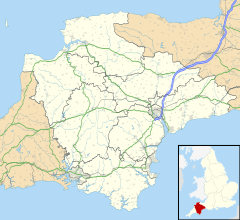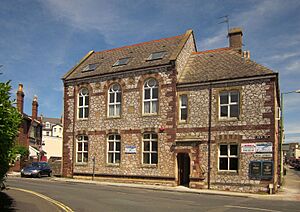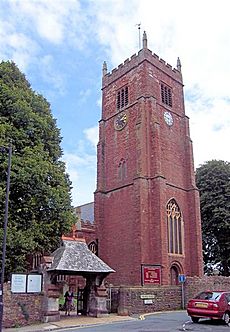Paignton facts for kids
Quick facts for kids Paignton |
|
|---|---|
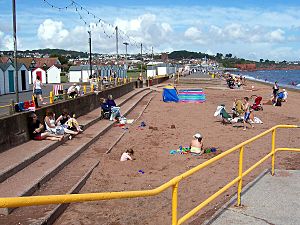 View along Preston Sands beach |
|
| Population | 67,520 (Built up area, 2021) |
| OS grid reference | SX8960 |
| Unitary authority | |
| Ceremonial county | |
| Region | |
| Country | England |
| Sovereign state | United Kingdom |
| Post town | Paignton |
| Postcode district | TQ3, TQ4 |
| Dialling code | 01803 |
| Police | Devon and Cornwall |
| Fire | Devon and Somerset |
| Ambulance | South Western |
| EU Parliament | South West England |
| UK Parliament |
|
Paignton (pronounced PAYN-tən) is a lively seaside town on the coast of Tor Bay in Devon, England. It's part of the Torbay area, which also includes the towns of Torquay and Brixham. This whole area is a popular holiday spot known as the English Riviera.
Paignton started out as a small settlement built by the Celts a very long time ago. It was first written about in a famous book called the Domesday Book in 1086. For many years, it was a quiet fishing village. A new harbour was built in 1847, and a railway line opened in 1859, connecting Paignton to Torquay and even London. As more people moved there, Paignton grew and joined up with the nearby villages of Goodrington and Preston. Paignton is about 25 miles (40 km) northeast of Plymouth and 20 miles (32 km) south of Exeter.
Contents
History of Paignton
Ancient Discoveries
In 1993, something amazing was found in Paignton! A Roman burial was discovered on the Hookhills estate. At first, people thought it was from the Stone Age, but later tests showed it was from between 230 and 390 CE. The burial was of a young woman, aged 15 to 25. She was buried with oysters, and her teeth showed she ate a lot of carbs and protein. Even though she lived near the sea, only a small part of her diet was seafood. This skeleton is the most complete one found in Devon, and you can see it at the Torquay Museum.
How Paignton Got Its Name
Paignton is mentioned in the Domesday Book of 1086 as Peintone. The name comes from old Anglo-Saxon words. Pæga was a person's name, -ing means "the people of," and tun means an enclosed area or homestead. So, it means "Pæga's people's settlement."
Long ago, the beach had low sand dunes and marshy land behind them. The first settlement grew on dry ground at the bottom of the hills. Another small fishing village grew near Roundham Head. The first church in Paignton was probably built from wood in the 700s.
Bishops and Markets
Later, the manor of Paignton was owned by the Bishop of Exeter. These bishops built the Bishop's Palace next to the church. Some parts of it, like the Coverdale Tower, are still standing today. A street called Winner Street got its name from "Wynerde," which might mean vineyards or wine traders from the Middle Ages.
In 1294, King Edward I gave the bishops permission to hold a weekly market and a yearly fair. This made Paignton a market town. However, the market became less important after the English Reformation in the 1500s.
Growth of a Seaside Town
Paignton stayed a small village, known for its grapes, cabbages, and cider, until the 1800s. In 1837, a new harbour was built. Around this time, the modern spelling, Paignton, started to be used. The older parts of Paignton, like Church Street and Palace Avenue, have beautiful Victorian architecture. Kirkham House is an old stone house from the late Middle Ages that you can visit. The Coverdale Tower, next to the church, is named after Bishop Miles Coverdale, who helped translate the Bible into English.
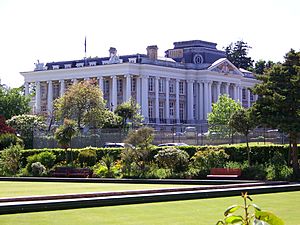
The railway line came to Paignton in 1859. This connected Paignton and Torquay to London, making it easier for visitors to come.
The Paignton Pudding
The Paignton Pudding is a famous local story! It was first made in the 1200s. These puddings were huge and only made sometimes. In 1859, a giant pudding was baked to celebrate the railway's arrival. Thousands of people came hoping to get a piece, and it caused a lot of chaos! This event became very well known. More recently, a Paignton Pudding was baked in 1995 to celebrate the market's 700th birthday, and again in 2006 for the 200th birthday of engineer Isambard Kingdom Brunel.
Oldway Mansion
Oldway Mansion is a large house with beautiful gardens. It was built in the 1870s for Isaac Merritt Singer, who made a lot of money from improving the sewing machine. Other buildings in Paignton, like the Palace Hotel, were built as homes for Singer's sons.
How Paignton is Governed
Paignton is part of the unitary authority of Torbay. This means that one local council, Torbay Council, manages most local services for Paignton, Brixham, and Torquay. Torbay Council is based in Torquay.
Paignton used to be an "ancient parish," which is a very old type of local area. It included the small villages of Goodrington and Preston, which later became part of Paignton as it grew. In 1863, Paignton got a local board to manage its services. This board built the Old Town Hall, Paignton in 1870.
Later, in 1946, the council bought Oldway Mansion to use as its main office because the old Town Hall was too small. In 1968, Paignton joined with Brixham and Torquay to form the county borough of Torbay. This made Torbay independent from the main Devon County Council for a while. In 1998, Torbay became a unitary authority again, which means it handles most local services on its own.
Most of Paignton is in the Torbay constituency for the UK Parliament. Some southern and western parts of the town are in the South Devon constituency. People in these areas vote for a Member of Parliament (MP) to represent them in the national government.
Economy and Tourism
Paignton's economy relies a lot on tourism. The town is known as a great place for family holidays. The main seafront area has the famous Paignton Pier, which is 780 feet (238 m) long and opened in 1879. It was designed by George Soudon Bridgman, who also designed the original Oldway Mansion.
The Festival Theatre opened in 1967 and used to put on big summer shows. In 1999, it was changed into a large cinema. The Torbay Air Show started in 2016 and happens every June over Tor Bay. The Paignton Festival, which is over 100 years old, takes place in late July. It has a big parade and lots of fun events on The Green.
Regatta Week in early August is the busiest holiday time. During this week, there's a funfair on Paignton Green and a big fireworks display. Later in August is Children's Week, with many events and competitions for kids. Paignton has many places to stay, plus lots of pubs, nightclubs, and restaurants.
Popular tourist attractions include Paignton Zoo and the Dartmouth Steam Railway. This railway runs steam trains from Paignton to Kingswear. From Kingswear, you can take a ferry across the River Dart to Dartmouth. The railway is now a heritage line, meaning it's preserved for its historical value. The 630-mile (1,014 km) South West Coast Path also runs along the coast here.
Suttons Seeds, a company that sells seeds and gardening products, is based in Paignton.
Places of Interest
The Paignton Picture House (now closed) is thought to be Europe's oldest cinema built specifically for movies. It opened in 1907. Seat 2, Row 2 in the circle was the favourite spot of crime novelist Agatha Christie, who lived nearby. It's said that the cinemas in her books were based on the Paignton Picture House. The cinema was also used for filming parts of the movies Ordeal by Innocence (1984) and The French Lieutenant's Woman (1981).
The Royal Bijou Theatre is no longer standing, but a special blue plaque marks where it used to be on Hyde Road. This theatre was where the famous opera The Pirates of Penzance by Gilbert and Sullivan had its first performance on December 30, 1879. This quick performance was done to make sure the show's British copyright was protected. The Palace Theatre in Palace Avenue is now the main theatre in town.
The department store Rossiters used to be a very important shop in Paignton until it closed in 2009. Some people say this store was the inspiration for the TV show Are You Being Served? In 2010, it reopened as a discount store.
From 1889 to 1897, the famous mathematician Oliver Heaviside lived in Paignton. You can see a blue plaque on the wall of the building where he lived, which is now a bank. Heaviside is buried in Paignton Cemetery.
Beaches

Paignton beach and Preston Sands are right next to each other at low tide. They are great for water sports like kite surfing and dinghy sailing. Both beaches are sandy and gently slope into the sea, with no strong currents. This makes them very popular for swimming and families. Both beaches also have green parks right behind them. Paignton Green has a pirate-themed Adventure Golf course and the Paignton Geoplay Park, a children's play area. This play area is themed around the local geology, inspired by the UNESCO Global Geopark that Paignton is part of.
Just east of Paignton Harbour is Fairy Cove. It doesn't have many facilities, but it's interesting because you can see the Torbay Breccia here. This is a red sandstone with pieces of rock that washed into it when the area was a desert long ago.
Also nearby is Goodrington, which has another popular beach called Goodrington Sands. Behind it is Young's Park, with a boating lake and a large outdoor waterpark called Splashdown Quaywest. Beyond Goodrington are Waterside and Saltern Coves, which are quieter and accessed through fields. Then comes Broadsands, near the border with Brixham.
The reed beds behind Broadsands beach are home to a rare bird called the cirl bunting. Hollicombe beach, at Paignton's northern edge, has a special geological site called the "Corbyn's Head Member." Elberry Cove is popular with jetski fans, while Saltern Cove is a Site of Special Scientific Interest because of its unique geology and sea life.
Transport
Railway
Paignton railway station is close to the town centre and just a short walk from the beach. Great Western Railway provides most of the train services. Trains run about every half hour to Torquay, Newton Abbot, Exeter, and Exmouth along the Riviera Line. Some trains go further to Taunton, Bristol, Cardiff, and London Paddington. CrossCountry also has a couple of services each day to Manchester Piccadilly station via Bristol.
Heritage Railway
Queen's Park station, for the Dartmouth Steam Railway, is right next to the main railway station, on the beach side of the level crossing. Steam trains run from February to December, and daily between April and October.
The other railway station in Paignton is Goodrington Sands, which opened in 1928 and is now part of the Dartmouth Steam Railway.
Buses and Coaches
The bus and coach station is opposite the main entrance to the railway station. Bus services are run by companies like Stagecoach South West. You can catch buses to places like Totnes and Plymouth; Torquay and Newton Abbot; Torquay, Teignmouth and Dawlish Warren; Brixham; and Kingswear (for the ferry to Dartmouth). There are also long-distance coach services provided by National Express.
Ferries
During certain seasons, you can take Ferry services from Paignton Harbour to Torquay and Brixham. These are run by Paignton Pleasure Cruises and We Ferry.
See also
 In Spanish: Paignton para niños
In Spanish: Paignton para niños


